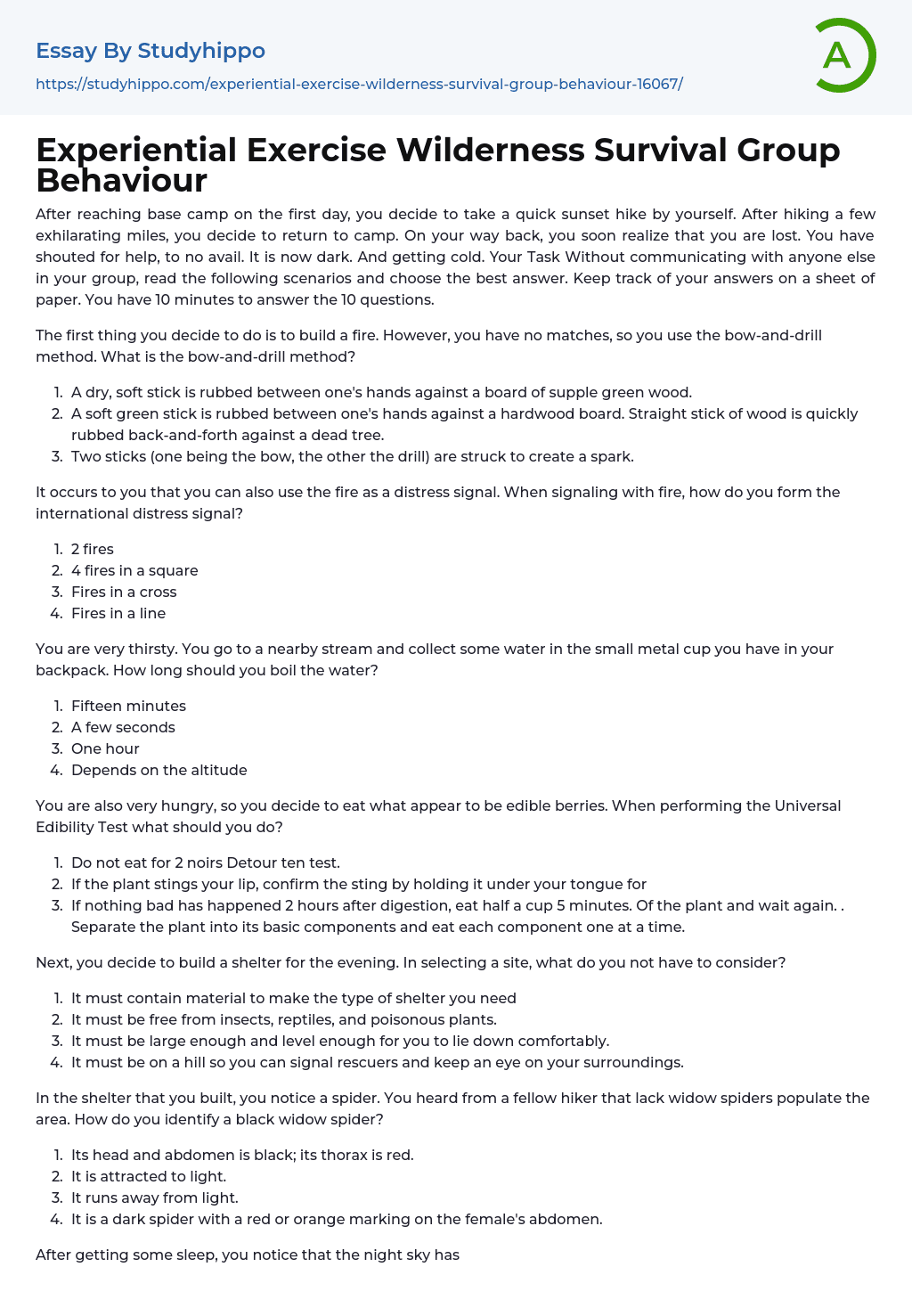

Experiential Exercise Wilderness Survival Group Behaviour Essay Example
After reaching base camp on the first day, you decide to take a quick sunset hike by yourself. After hiking a few exhilarating miles, you decide to return to camp. On your way back, you soon realize that you are lost. You have shouted for help, to no avail. It is now dark. And getting cold. Your Task Without communicating with anyone else in your group, read the following scenarios and choose the best answer. Keep track of your answers on a sheet of paper. You have 10 minutes to answer the 10 questions.
The first thing you decide to do is to build a fire. However, you have no matches, so you use the bow-and-drill method. What is the bow-and-drill method?
- A dry, soft stick is rubbed between one's hands against a board of supple green wood.
- A soft green stick is rubbed between one's
...hands against a hardwood board. Straight stick of wood is quickly rubbed back-and-forth against a dead tree.
- Two sticks (one being the bow, the other the drill) are struck to create a spark.
It occurs to you that you can also use the fire as a distress signal. When signaling with fire, how do you form the international distress signal?
- 2 fires
- 4 fires in a square
- Fires in a cross
- Fires in a line
You are very thirsty. You go to a nearby stream and collect some water in the small metal cup you have in your backpack. How long should you boil the water?
- Fifteen minutes
- A few seconds
- One hour
- Depends on the altitude
You are also very hungry, so you decide to eat what appear to be edible
View entire sampleJoin StudyHippo to see entire essay
berries. When performing the Universal Edibility Test what should you do?
- Do not eat for 2 noirs Detour ten test.
- If the plant stings your lip, confirm the sting by holding it under your tongue for
- If nothing bad has happened 2 hours after digestion, eat half a cup 5 minutes. Of the plant and wait again. . Separate the plant into its basic components and eat each component one at a time.
Next, you decide to build a shelter for the evening. In selecting a site, what do you not have to consider?
- It must contain material to make the type of shelter you need
- It must be free from insects, reptiles, and poisonous plants.
- It must be large enough and level enough for you to lie down comfortably.
- It must be on a hill so you can signal rescuers and keep an eye on your surroundings.
In the shelter that you built, you notice a spider. You heard from a fellow hiker that lack widow spiders populate the area. How do you identify a black widow spider?
- Its head and abdomen is black; its thorax is red.
- It is attracted to light.
- It runs away from light.
- It is a dark spider with a red or orange marking on the female's abdomen.
After getting some sleep, you notice that the night sky has cleared, and so you decide to try and find your way back to base camp. You believe you should travel north and can use North Star for navigation. How do you locate the North Star?
- Hold your right hand up as far as you can and look between your index and middle fingers.
You will have approximately 20 minutes for the group task. Scoring your answers your instructor will provide you with the correct answers which are based on expert judgments in these situations (wry. Wilderness-survival. Net). Once you have received the answers, calculate: your individual score; your group's score; the average individual score in the group; the best individual score in the group. Write these down, and consult with your group to ensure that these scores are accurate.
- How did your group (B) perform relative to yourself (A)?
- How did your group (B) perform relative to the average individual score in the group (C)?
- How did your group (B) perform relative to the best individual score in the group (D)?
- Compare your results with those of other groups. Did some groups do a better Job of outperforming individuals than did others?
- What do these results tell you about the effectiveness of group decision making?
- What can groups do to make group decision making more effective?
- Action Potential essays
- Blood essays
- Body essays
- Brain essays
- Childbirth essays
- Eye essays
- Glucose essays
- Heart essays
- Human Physiology essays
- Immune System essays
- Kidney essays
- Muscle essays
- Nervous System essays
- Neuron essays
- Poison essays
- Puberty essays
- Sense essays
- Skeleton essays
- Skin essays
- Activity essays
- Believe essays
- Comfort Zone essays
- Dance essays
- Fashion essays
- Fishing essays
- Fitness essays
- Freedom essays
- Habits essays
- Healthy Lifestyle essays
- Hobby essays
- Hunting essays
- Interests essays
- Justification essays
- Moment essays
- Optimism essays
- Peace essays
- Perfume essays
- Shoes essays
- Shopping essays
- Silence essays
- Superstition essays
- Survival essays
- Vegetarianism essays
- Welfare essays
- Worldview essays



